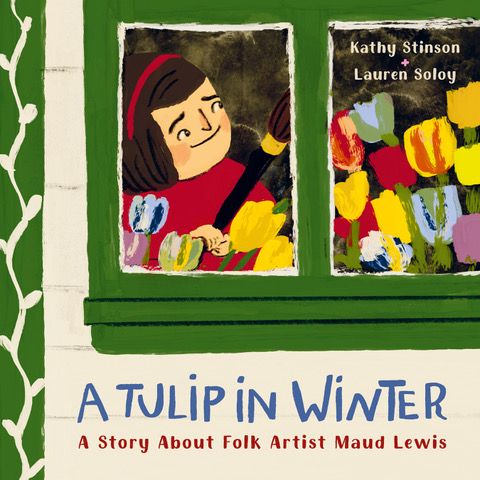 March
07
March
07
Tags
HER WHOLE LIFE IN A BOOK FOR CHILDREN – WHY? WRITING A TULIP IN WINTER: A STORY ABOUT FOLK ARTIST MAUD LEWIS BY KATHY STINSON
A picture book biography often focuses on its subject’s childhood but A Tulip in Winter spans Maud’s whole life (1903-1970).
When Maud was young, she loved playing piano. But before long, a condition she was born with, later known to be rheumatoid arthritis, worsened. Her hands grew too bent and her fingers too stiff to continue. Her mother introduced her to painting.
I imagined that for Maud “Red [paint] on white [paper] made its own kind of music.”
Maud went on from there to become one of the world’s most celebrated folk artists.
HER WHOLE LIFE IN A BOOK FOR CHILDREN? WHY?
Maud’s ability to look beyond hardship throughout her life to see beauty in the everyday is an inspiration to everyone who learns about her.
As Maud grew to adulthood, she was still often treated like a child, in large part because of her disability. Kids will relate and feel the unfairness.
The paintings she created as an adult appeal to all ages.
Kids will be especially amused and enchanted by what the woman did to the house she lived in for the last decades of her life.
Of course, some things had to be left out, because of space limitations, what would interest a child, and what a child can understand, without complicated explanations, about societal attitudes long ago.
AN OUT-TAKE
When Maud was twenty-five and still unmarried, she gave birth to a baby whose father had left Maud. Maud’s father gave the baby to a married couple to raise, and told Maud the baby had died.
Thinking that this heartbreaking part of Maud’s life would help show her remarkable resilience — that she could go on from there to create such joyful art — I wrote:
As a young woman, Maud knew great sadness. The man she loved left her.
She had a baby she wasn’t allowed to keep.
But I soon saw that these sentences would raise more questions than there would be room to answer without totally pulling readers out of the story. And there was plenty more that was tough about this part of Maud’s life for readers to get the point that here was a woman who had to overcame great adversity in order to pursue her passion!
THE BOOK’S TITLE
Thinking of a good title for a book is often difficult for me, but as soon as I hit on A Tulip in Winter, it felt instantly right. For one thing, Maud loved combining seasons in one painting. Also, I think of Maud herself as “a tulip in winter.” I think her art is like a tulip in winter too — unexpected and uplifting.
MAUD’S HOUSE
In addition to painting on scraps of scavenged wood and canvas, Maud covered almost every surface of the house she and her husband lived in with exuberant colour. (She even painted the woodstove!)
Maud’s house was such a wonderful expression of her talent, her love of nature, and her sense of humour, that I couldn’t resist using it as frame for A Tulip in Winter. Here’s how it begins:
I love how Lauren Soloy’s illustrations emulate and pay tribute to Maud’s joyfully exuberant style.
The little house Maud lived in with her husband Everett Lewis is now nestled inside the Art Gallery of Nova Scotia as part of the province’s proud display of Maud’s art!
MAUD LEWIS’S LEGACY
The Digby Courier once said that Maud Lewis lived her life in a way that “shed beams of sunshine in the homes of others.”
A child visiting the Maud Lewis exhibit at the Art Gallery of Nova Scotia said, “She painted what she saw, only she made it look better.”
I hope A Tulip in Winter will inspire young readers everywhere
- to appreciate Maud’s art
- to try creating paintings of their own
- to find and focus on the beauty in their difficult worlds
- to “shed beams of sunshine” — in their own ways — into the lives of others and
- to face with Maud-like courage any obstacles they face in the pursuit of their passions.Happy reading!
~~~~~~~~~~~~~~~~~~~~
Kathy Stinson is the author of a wide range of books for children and adults, including the classic Red Is Best and the TD Canadian Children’s Literature Award–winning picture book The Man With the Violin.







Wow, this sounds like a fascinating story. Thanks for sharing. I’ll look for it and good luck with your book!
Thanks Laura!
I love Maud Lewis’s paintings! And every year hang a calendar of her work on my kitchen wall. Maud’s painted house is wondrously preserved at the AGNS in Halifax, a delight to visit. Yes Kathy, from your first book (of which I have an early copy) to this one, Red is Best! I can’t wait to own a copy of this book too.
That’s lovely, Marie. Thank you!
I am fascinated by her after seeing a movie about her life and this is wonderful to see
Maud was an amazing woman, to be sure. Beth, I hope you’ll enjoy the book as much as you did the movie!
Thanks, kathy